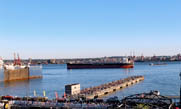In the global trade landscape, container shipping plays a crucial role in facilitating the movement of goods across the world. Among the various shipping options available, full container load (FCL) transportation stands out as a preferred choice for many businesses. This article aims to provide an in-depth understanding of FCL transportation, its benefits, and the process involved.
Full container load transportation refers to the shipping of goods in a single container, which is fully occupied by the shipper. Unlike less than container load (LCL) transportation, where goods from multiple shippers are consolidated in a single container, FCL offers several advantages. Firstly, it provides shippers with greater control over the handling, storage, and transportation of their goods, ensuring that they remain intact and secure throughout the journey. Secondly, it reduces the risk of damage or loss, as the goods are not mixed with those of other shippers. Lastly, FCL transportation is often more cost-effective for shippers with large volumes of goods to transport.
The process of FCL transportation begins with the selection of the appropriate container size. Containers come in various sizes, such as 20 feet, 40 feet, and 45 feet, each suitable for different types of goods and quantities. Shippers need to assess their cargo volume and choose the most suitable container size to optimize space and cost.
Once the container size is determined, the shipper must prepare the goods for loading. This involves packaging the goods securely to prevent damage during transportation and ensuring that they comply with international shipping regulations. The shipper must also provide accurate documentation, including the bill of lading, commercial invoice, and customs declarations, to facilitate the customs clearance process.
After the goods are prepared, they are loaded into the container at the loading terminal. The process is carried out by trained professionals who ensure that the goods are loaded safely and securely. The container is then sealed and secured, and the shipper receives a seal number, which will be used to track the container throughout its journey.
Once the container is loaded, it is transported to the port of origin, where it is loaded onto a cargo ship. The shipping line then arranges for the transport of the container from the origin port to the destination port. During the journey, the container is subject to various factors, such as weather conditions, sea waves, and cargo handling, which may affect its integrity.
Upon arrival at the destination port, the container is unloaded and transported to the customs clearance terminal. The shipper must provide the necessary documentation to clear customs, which may involve inspections and payment of duties and taxes. Once customs clearance is complete, the container is transported to the final destination, where the goods are unloaded and delivered to the consignee.
One of the key benefits of FCL transportation is its efficiency. Since the container is fully occupied by the shipper, there is no need for transloading or consolidation, which can save time and reduce the risk of damage. Additionally, FCL transportation offers greater flexibility, as shippers can choose the most suitable shipping route and schedule that meets their requirements.
However, FCL transportation also has some drawbacks. One of the main disadvantages is the high cost, especially for shippers with small or irregular cargo volumes. Furthermore, FCL transportation requires careful planning and coordination, as the shipper must ensure that the goods are ready for loading and that all necessary documentation is in order.
In conclusion, FCL transportation is a popular and efficient shipping option for businesses with large volumes of goods to transport. Its advantages, such as greater control, reduced risk of damage, and cost-effectiveness, make it an attractive choice for many shippers. However, it is essential to carefully plan and coordinate the process to ensure a smooth and successful shipment.

——END——
https://www.fanjue56.com/guojihuodai/91912.html,以上就是海运中整柜运输英文的解读,只要通过预约方式联系我们的顾问客服根据不同进口产品, 即可获得国际货运方案和进口报关代理报价单,手续费低,省钱,省心。工作人员看到您的信息会第一时间与您联系,文章图文源于网络和投稿、即编辑排版,传递更多知识,如涉及版权,请及时联系我们会尽快处理。如果您还有其他疑问,欢迎致电400-0031-521.

